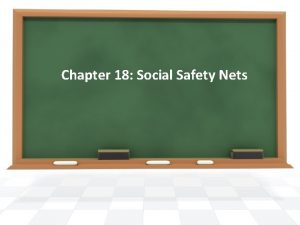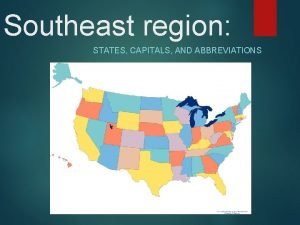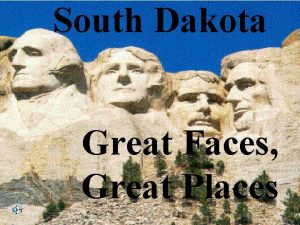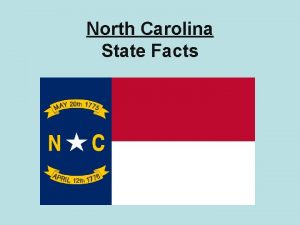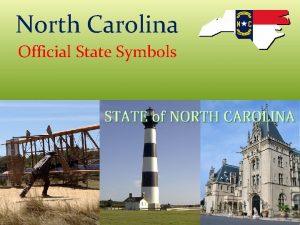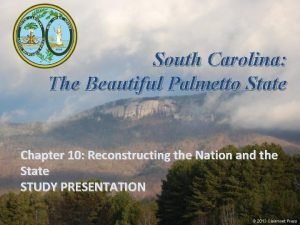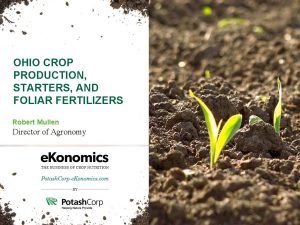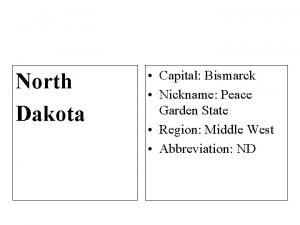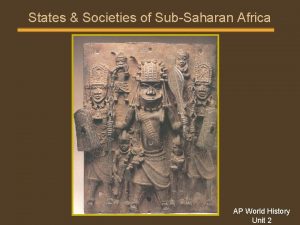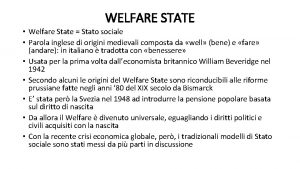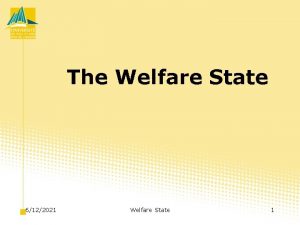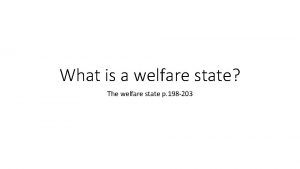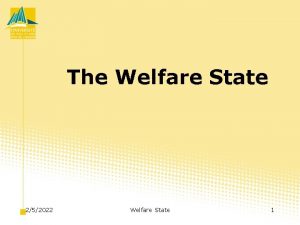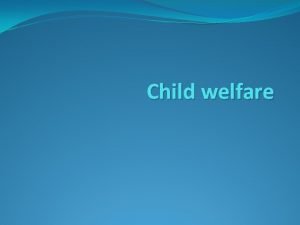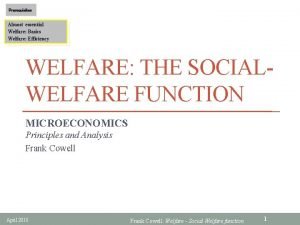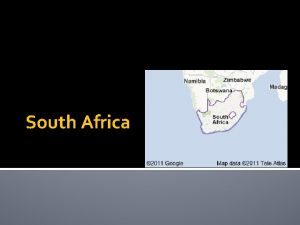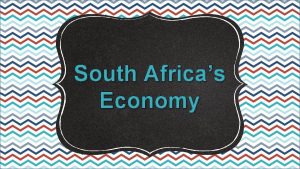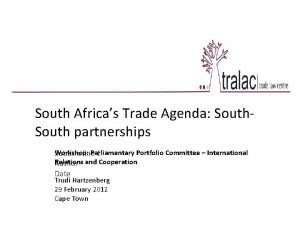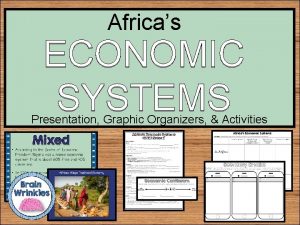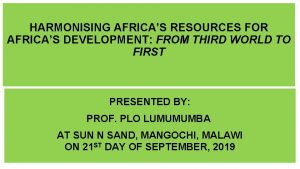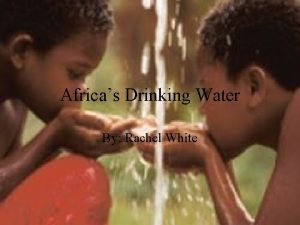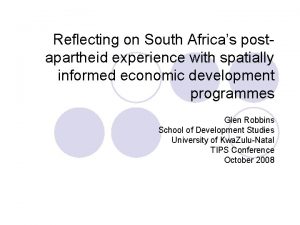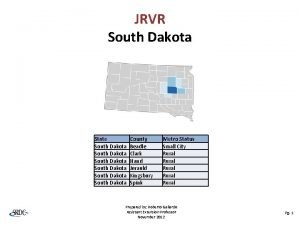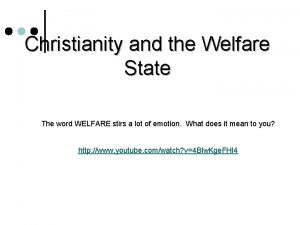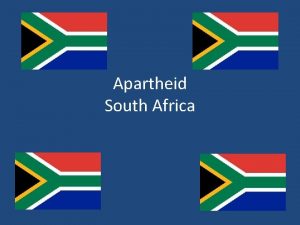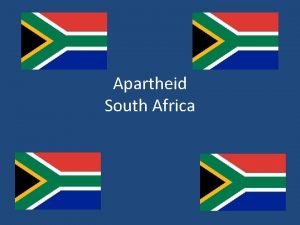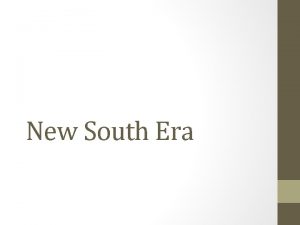Africas First Welfare State The Experience of South



























- Slides: 27

‘Africa’s First Welfare State’ The Experience of South African Firms Doing Business in Botswana South African Institute of International Affairs 17 May 2005

Outline n n n n Methodology Key economic data SA trade and investment linkages with Botswana Results of SAIIA survey Impact of SA business presence/FDI Policy recommendations Key findings 2

Methodology n n Qualitative and quantative in-country survey of SA companies in Botswana Representative sample group – every sector Interviews with gov departments, academics, donor agencies, development bodies, private sector institutions Data from companies supplemented by BIDPA, BOB, BEDIA, MFDP, UNCTAD and others 3

Socio-Economic Snapshot 2002 Population 1. 7 m GDP $7 bn GDP growth 3. 1% GNI per capita $3, 010 Inflation 8% Foreign reserves $5. 4 bn Gross savings/GDP 38. 5% External debt $480 m 4

GDP by Economic activity Agriculture Mining Manufacturing 1966 42. 7% 5. 7% 1975/76 20. 7% 17. 5% 7. 6% 2000/01 2. 6% 36. 5% 4. 1% Water/Electricity Construction Trade, hotels Transport Banking 0. 6% 7. 8% 9. 0% 4. 3% 20. 1% 2. 3% 12. 8% 8. 6% 1. 1% 4. 7% 2. 4% 5. 8% 10. 3% 3. 8% 10. 9% Social services Government 9. 8% 2. 8% 14. 6% 4. 0% 16. 0% GDP growth - 18. 4% 5

Sectoral breakdown of GDP, 2003 6

NDP 8 Gov budget Review (Estimates and Actual, P m) Revenues 1997/8 2002/3 % share Minerals SACU 3, 627 4, 681 1, 163 6, 986 7, 040 1, 112 55. 3% 53. 7% 11. 6% SACU BOB Other Taxes Total 1, 186 1, 751 947 1, 274 1, 467 7, 815 8, 281 1, 554 9, 427 6, 848 9, 690 15, 626 57, 816 69, 170 14. 3% 16. 3% 9. 9% 16. 8% 22. 7% 100% 7

Total number of employees by sector, BOB Sector 1995 2001 Agriculture 4, 467 5, 997 Mining 8, 408 8, 252 Manufacturing 23, 381 30, 874 Electricity/water 2, 594 2, 861 Construction 22, 084 28, 470 Commerce 44, 944 49, 904 Transport/Communications 9, 006 10, 120 Finance 17, 452 19, 177 Community/Personal Services 10, 097 4, 238 Education 3, 608 6, 480 Central Government 69, 426 85, 354 Local Government 15, 921 21, 040 Total 231, 387 272, 812 8

Is Botswana facing a new economic paradigm? n n Far-sighted use of foreign reserves: free education, health services, housing, entrepreneurship (40% of budget on social development and reaches 40% of population) – 90% of development funds provided by Botswana government (cumulative development spending 70% higher than initially envisaged) Presented a budget deficit in 1998/99, after 16 years of operating a budget surplus (last budget deficit 1982/83) Slowdown compounded by: global economic downturn after 2001, diamond production has peaked, foot & mouth disease, HIV/Aids, drought, Zimbabwe crisis Vision 2016: eradicate absolute poverty – requires 9 growth of 8% (instead 4 - 5% expected)

Trade and investment linkages: SA and Botswana l Shared cultural and colonial history – familiar, operating environment l Pragmatic political stance l Defining feature of South Africa’s economic relationship with Botswana is SACU l SA is Botswana’s largest import partner, whereas majority of Botswana’s exports directed at Europe (perpetuates North. South trade linkages despite SACU) l Enjoys healthy trade surplus with the rest of the world l Exports: R 6, 419 bn & imports R 403 m. 10

Botswana’s trade partners, 2001, BOB Region Exports Imports SACU 6. 5% 77. 6% Zimbabwe 2. 6% 3. 2% Other Africa 1. 1% 0. 3% EU 79. 1% 12. 3% US 1. 0% 1. 8% Other 0. 2% 4. 5% 11

Investment by Source, 2000, BOB Country FDI % South Africa 60. 9% Luxembourg 25. 2% UK 9. 9% US 1% Middle East 1% 12

Value of Investment by country, Pm Country 1997 1998 1999 2000 2001 2002 RSA 3, 311 3, 871 3, 940 6, 572 6, 829 5, 423 Luxbrg 1, 331 2, 010 2, 262 2, 561 3, 081 3, 356 UK 118 113 1, 303 1, 111 814 673 Germany 616 761 859 1, 208 18 181 Japan 224 306 196 74 549 851 US 448 465 226 340 385 32 13

Investment by Sector, 2000, BOB Sector FDI % Other % Mining 79. 3% 28. 6% Manufacturing 3. 5% 4. 9% Finance 6. 3% 2. 9% Retail 7. 9% 2. 0% Electricity 0 8. 4% Property/Finance 1. 6% 1. 5% Transport 1. 1% 2. 7% Construction 0. 1% 0. 5% Tourism 0. 2% N/a Public Administration 0 48. 2% Other 0 0. 3% 14

FDI inflows: select SADC countries, 1989 – 2002, $m Year Botswana Namibia Mozambique 1989 -1994 -29 1995 70 1996 70 1997 100 1998 90 1999 37 2000 54 2001 26 2002 37 70 153 129 72 84 77 111 153 275 181 64 235 385 139 255 406 15

Comparison: FDI Stock as % of GDP, 1999, UNCTAD Country Botswana South Africa Zambia Percentage 23% 42% 74% Lesotho Namibia Singapore Malaysia Ireland 36% 53% 97% 65% 51% 16

Results of SAIIA Survey l l l Many SA company involvement predate 1994 (attracted by generous incentives and political stability) Several companies settled so long – regard themselves as indigenous Botswana companies Many newcomers in retail, franchise – highly visible – strongly associated with South Africa motivated by SACU (duty free access), high disposable income, safe environment, geographical proximity, infrastructure, labour Largest investment into mining, De Beers through Debswana (Orapa mine) Dominant players in market: primarily Greenfield and acquisitions, some joint ventures 98% of employees are locals (represented at every 17 level)

Results cont. l l l Business friendliness: Very favourable (incentives foreign-owned businesses, receptiveness of gov to policy input, low corruption) FDI incentives: foreign exchange controls abolished in 1999, corporate tax 15% (manufacturing companies + IFSC), no prohibitions on foreign ownership, maximum personal and marginal tax rate 25% (region’s average – 35%), VAT of 10% also lowest in SADC Private-public relations on sound footing Strong confidence in the courts Some companies that have been in Botswana over 15 years did complain about deteriorating business 18 morals

Main constraints l l l Dominant role of government indirectly flagged re cost of utilities, unfair competition of parastatals, lack lustre performance outside mining High confidence in fiscal prudence and sound management policy, as well as acknowledgement of broader debate of role of governments in developing societies Market size most critical concern (high disposable income misleading – high inequality (24% under $1 a day, 50% under $2 a day), payment difficulties - highly indebted society, access to finance difficult (prime rate about 15%), still cash-driven economy 19

Main constraints cont. l l l Labour: Lack of skilled labour, biased towards British system, qualified unemployment, also result of rapid growth of economy and impact of HIV/Aids, xenophobia (lowest ranking that Botswana has ever received from Africa Competitiveness Survey (20 th out of 24 th) in 2001 Bureaucracy: slow processing of work permits Unfair competition: Construction and property development (profit margins in infrastructure development slim, BOT projects rare) Cost of utilities high: Water and electricity (drives up manufacturing costs) Constraints identified close correlation with WEF 20 survey

Impact of SA investment l l l SA investors have had considerable impact (early entry & number of companies), prudent management of diamonds with De Beers laid foundation for economy Contributed to diversification of economy, employment creation, raised competitive levels, instill business culture, built local capacity Make contributions to medical aid & pension funds, severance benefits, social programmes Some concern about ‘hegemonic’ influence of SA business (enforced huge trade imbalance, negligible domestic linkages between two economies) SA retailers have taken advantage of building of several malls (anchor tenants), however, sector is 21 overtraded

Impact cont. l l l Despite encouragement to procure locally – most companies procure from SA Botswana suppliers complain retail sector uses country as a market for SA products, undermining local manufacturing capacity, buying authorities located in SA, no trade-off between two countries Many restaurant franchises catering for urban youth + upwardly mobile middle class – viewed positively creating local employment, transfer business skills, ingredients obtained locally (support agri sector) Although SA most significant investor in Botswana, has not fulfilled government’s employment targets, nor significant impetus to improve local manufacturing Some gov officials and academics expressed open 22 disappointment in quality of SA investment

Negative impact of SA policies on Botswana’s economic objectives l l Survey found that many economic policies adopted by the SAG to address local imbalances economy have unintended consequences in Botswana Examples: Failure of Hyundai Assembly plant in 2000, the EU TDCA, SA tax legislation on IFSC, exchange rate volatility In 2001 the SAG introduced new tax legislation requiring SA companies operating in foreign countries that charged a lower tax rate then in SA to pay additional taxes if it was less than 90% than the SA rate – affected all SA companies operating in Botswana Only addressed in 2003 when new double taxation 23 agreement was concluded

Policy Recommendations to Botswana - BEDIA to be strengthened Appointment of foreign skilled workers Utility costs to be brought down Priority to employment creation Stigma of HIV/Aids to be addressed Increase productivity levels - - - Small business should receive priority Regulation (property and banking sector) strengthened Act more quickly on issues raised by private sector Exploit other resources (gas, gold, coal) 24

Policy Recommendations to South Africa - - - Great deal of sensitivity about SA dominance More high-level meetings on a functional level Joint education and training programmes – business skills improved Encourage reputable SA companies to move into Botswana market - - - Joint industrialisation policies should be considered SADC governments encouraged to use contractors from the region Economic relations should not be regarded as a zero-sum game 25

Key Findings n n n Small, landlocked economy such as Botswana very vulnerable to developments in the region – closer relationship with SA necessary Despite strong economic growth since independence, not significant increase in jobs (sound macroeconomic environment, less successful micro-economic environment) – More cost sharing mechanisms required Skills important to address diversification n Quality of investment outside mining disappointing (faces constraints typical of many African countries, not integrated into global production hubs) Goal set to reduce number of people living in poverty to zero by 2016 (requires investment of 41% of GDP per annum) Deserves credit for integrated, long-term vision for its society and economy. 26

Thank you l Neuma Grobbelaar Head Business in Africa Research project Contact details: grobbelaarn@saiia. wits. ac. za 27
 Whats africas largest lake
Whats africas largest lake Imprinting meaning psychology
Imprinting meaning psychology Continuity vs discontinuity
Continuity vs discontinuity Indirect experience examples
Indirect experience examples Pros and cons of welfare state
Pros and cons of welfare state Old south vs new south streetcar named desire
Old south vs new south streetcar named desire First year seminar
First year seminar South carolina state firefighters association
South carolina state firefighters association Southeast abbreviations and capitals
Southeast abbreviations and capitals Great faces great places
Great faces great places South carolina the beautiful palmetto state
South carolina the beautiful palmetto state What is nc state bird
What is nc state bird What is the state shell of north carolina
What is the state shell of north carolina South carolina the beautiful palmetto state
South carolina the beautiful palmetto state Crop lien system
Crop lien system South dakota state university
South dakota state university Garden state nickname
Garden state nickname State of emergency declared south africa
State of emergency declared south africa Sc wh 1605
Sc wh 1605 Ap art history
Ap art history Hát kết hợp bộ gõ cơ thể
Hát kết hợp bộ gõ cơ thể Frameset trong html5
Frameset trong html5 Bổ thể
Bổ thể Tỉ lệ cơ thể trẻ em
Tỉ lệ cơ thể trẻ em Chó sói
Chó sói Tư thế worms-breton
Tư thế worms-breton Chúa yêu trần thế alleluia
Chúa yêu trần thế alleluia Các môn thể thao bắt đầu bằng từ đua
Các môn thể thao bắt đầu bằng từ đua




